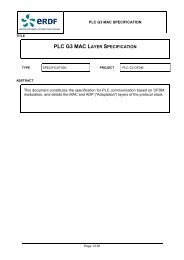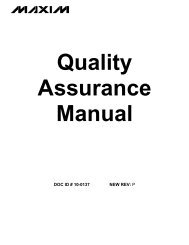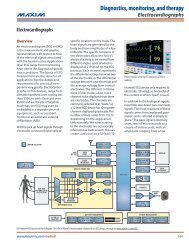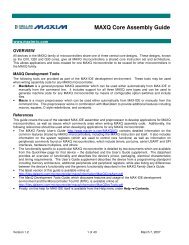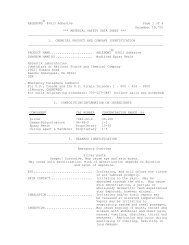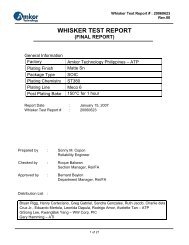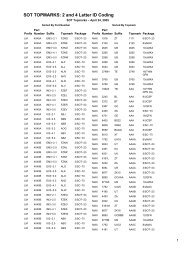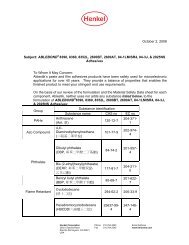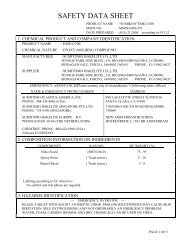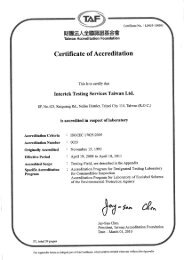Smart Grid Solutions Guide - Maxim
Smart Grid Solutions Guide - Maxim
Smart Grid Solutions Guide - Maxim
Create successful ePaper yourself
Turn your PDF publications into a flip-book with our unique Google optimized e-Paper software.
Energy measurementOverviewbudgets, for predicting maintenance,and for understanding the strain ona system.Figure 1 shows the power consumptionof a laptop computer using twodifferent plug-in power supplies.Even though the actual load is thesame, the power supplied from theline by the utility, called apparentpower, is substantially differentfrom the power consumed by theload, called active power. Suchdifferences lead to unnecessary andunaccounted for power loss. Withenergy-measurement solutions,statistics can be used to adjust deviceoperating behavior to optimizeenergy efficiency.Measurement accuracy is importantto effectively protect against powerfailures and safeguard equipment.Small drops in voltage or linefrequency can indicate pendingpower failure, enabling devicesto switch into a protection mode.Additionally, voltage zero-crossinginformation can be used to timewhen relays should be turned onand off to reduce wear from arcing.Measuring data centerefficiencyData centers are getting a lotof attention. The EnvironmentalProtection Agency (EPA) estimatesthat data centers accounted for 1.5%of U.S. electricity consumption in 2006,and this demand is expected tonearly double by 2011, necessitatingthe development of an additional 10power plants. Increasing data centerenergy efficiency can help avoidthese infrastructural costs, whileoffering data center operators significantsavings on their electricity bills.ENERGY STAR recently releasedguidelines for data centers tomitigate this demand throughincreased energy efficiency. Keyto these guidelines is a new metriccalled power usage effectiveness(PUE), which measures facility infrastructureefficiency. PUE is calculatedby dividing total data center energyconsumption by the IT equipmentenergy consumption. This requiresmetering at multiple locations withinthe data center, including the uninterruptiblepower supply (UPS) andpower distribution units (PDUs).Real-time power consumption data isneeded to prevent costly overloadingof breakers, as well as overallocationto equipment in idle or standbymodes. Armed with this information,data center managers can implementoperational strategies for dynamicpower capping and reallocation tomaximize PUE.An added benefit of energy-measurementsystems is that they give datacenter managers early failure notificationso that preventative maintenancecan be scheduled. Early-warningnotification provides the extra timeneeded to seamlessly utilize aredundant option before failure.Energy-measurement systems enablecontinuous monitoring of the healthof the power network. This capabilityis especially important as equipmentis sequenced, because it can allowmechanisms that avoid circuitoverloads such as those foundduring a black-start recovery.Energy-measurement SoCsImplementation of intelligent powermanagementalgorithms requires clearrepresentation of both actual powerconsumption and actual demand.This necessitates high accuracy andmultiple metrology functions,including: distortion; active, reactive,and apparent power; energy; RMSvoltage and current; and frequency.This information provides valuablefeedback for improving operatingefficiency, preventing power failure,and facilitating power-up sequencingduring a black start.Measurement accuracy is determinedby resolution, precision, and dynamicrange. Many general-purpose MCUsare limited in their accuracy anddynamic range because of their 10-or 12-bit ADCs. Discrete designs,meanwhile, require multiple components,in-depth knowledge of ACmetering, and extensive developmenttime.Today, SoCs are available thatbring the capabilities of intelligentmetering to individual devices, fromPOLs to PDUs. Advances in manufacturingand design technologyenable the metrology contained ina single SoC to meet critical cost,functionality, robustness, and sizerequirements. Today's state-of-theartSoCs can now be integrated intoserver cabinets, UPSs, AC-DC powermodules, PDUs, smart appliances,and luminaires.Figure 2. A ZigBee®-based outlet-monitoring unit.Figure 2 shows an easy-to-use datacollection system for POLs. Thislow-cost outlet-monitoring unitdemonstrates the capabilities ofthe 78M6612 energy-measurementSoC. It allows users to collecttime-stamped data from a poweroutlet and wirelessly transfer it forgraphical analysis or comparisonto a reference meter.The 78M6612 AC-power-monitoringSoC can measure from 10mA to20A with less than 0.5% measurementerror across a wide -40°Cto +85°C temperature range. Itsonboard 22-bit ADC enables this42 <strong>Maxim</strong> <strong>Smart</strong> <strong>Grid</strong> <strong>Solutions</strong>




